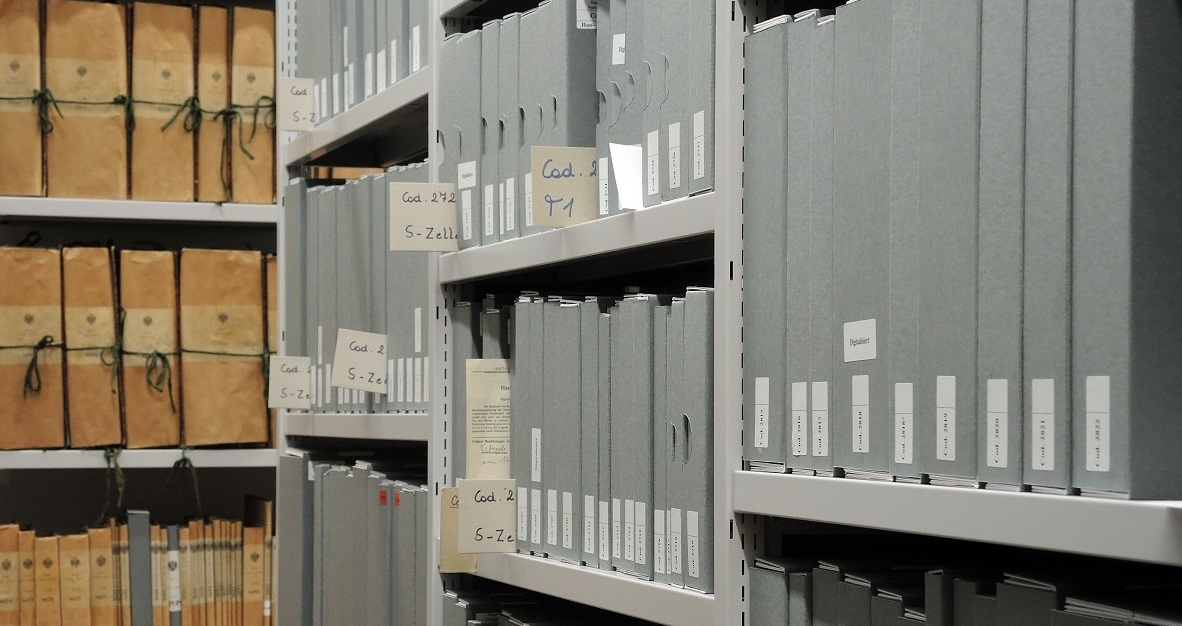Caring for holdings at the Austrian National Library

The importance of the material
The length of time that books and pictures survive depends significantly on the materials with which they were produced and which they come into contact with.
For instance, the paper of manuscripts or early prints from the 15th century are in better condition than prints from the time after 1850. During the Industrial Revolution, many more raw materials were needed very quickly. It was not possible to meet this demand by processing rags in the conventional way. Wood was discovered as a raw material to produce paper. However, paper containing wood pulp is acidic. From the 19th century, acidic paper was also glued. Acids attack the cellulose molecules and shorten the length of molecule chains. This causes the paper to turn brown and brittle. Extended contact between good hand-made paper and paper containing wood pulp may even result in the hand-made paper turning brown.
This is an example that demonstrates how important it is to surround valuable objects with nothing but the right materials. We are talking about archivable materials pursuant to the ISO standard 9706, 1994. They are free from wood pulp, have an alkaline reserve and do not contain any optical whiteners.
Similarly, glues, colours and materials used during restoration, storage or in an exhibition must be tested to check if they are suitable for this purpose. An example here is the “Oddy test”, which shows if the materials used give off harmful vapours. Any materials coming into direct contact with objects must still be stable and removable in 100 years.
Proper storage
Proper storage in focus: the manner in which valuable objects are stored can contribute significantly to ensuring that they survive for years without suffering a
Proper storage in focus: the manner in which valuable objects are stored can contribute significantly to ensuring that they survive for years without suffering any damage.
Criteria for spatial conditions:
- Clean, contaminant-free
- No daylight
- No water pipes
- Stable climate / climate monitoring
- Ventilation system
- Fire safety precautions
- Alarm system
Different types of containers:
- Covers made from acid-free archive paper protect book covers from light, dust, wear and scratches.
- Book slipcases preserve the book cover and the body of the book from mechanical damage and dust.
- Tailored boxes from acid-free corrugated board offer manuscripts and valuable printed writings the ideal protection against mechanical effects, as well as against light, dust and air pollutants.
- Individual sheets are well kept in folders.
- Valuable pictures and photographs are mounted in passe-partouts made from museum cardboard. Several folders and passe-partouts can be stored in archive boxes.
- We keep large formats such as maps and posters in folders in cabinet drawers.
- Photo archive covers made from non-buffered paper protect photo positives and photo negatives.
Positioning of books
- Vertically
- Neither too loosely nor too tightly
- Use book supports
- Similar formats are next to each other
- Large volumes are stored horizontally
- Sufficient space between the book edges and the shelves above them
Storing pictures
- Flat and lying down
- In folders, on cardboard bases or in passe-partouts
- Folders in boxes
- Large formats in folders in cabinet drawers
Storing photographs
- In photo archive covers that are not alkaline buffered
- Flat and lying down in folders and passe-partouts
- Glass plate negatives vertically along the longitudinal axis
The effects of climate and light
Climate conditions have a major impact on books, pictures and photographs:
Varying air humidity means that the various materials expand and contract differently. This can create tension, leading to crinkling or even tears. Sharp changes in climate conditions are much more harmful than slow changes.
Air humidity
Relative air humidity of over 60% may result in the growth of microorganisms that, on the one hand are not healthy for people and, on the other, damage the material – in some cases destroying it completely. Consequently, air humidity should be between 40% and 60%. A value of around 50% is ideal for books and pictures on paper. The temperature should not exceed 26°C.
Light irradiation
Extended periods of exposure to light bleaches colours and photographs and also results in materials being destroyed. This can sometimes be observed in leather book spines, which have a completely different colour to the rest of the cover and are seriously degraded. It is not possible to repair damage to colours caused by exposure to light. As a result, we try to ensure that the works entrusted to us have as little exposure to light as possible: through the level of illumination and the duration of the exposure.
